FINNISH AID TO DISRUPT NAZI ORE IMPORTS
London, England · December 19, 1939
The Winter War between Finland and the Soviet Union broke out on November 30, 1939, 2‑1/2 months after Adolf Hitler and Joseph Stalin had partitioned Poland between themselves. The French and British governments strongly desired to aid the Finns with volunteers and war materiel. The only possible route for such aid was through the Scandinavian countries of Norway and Sweden, both neutrals. The Allied Supreme War Council, consisting of British and French military advisors, decided on this date in 1939 to send help to Finland, should help be requested, against the wishes of the neutral Scandinavian states. The Allies recognized that this new situation would give them a chance to interrupt German imports of Swedish iron ore (9 million tons out of 22 million in 1938) if Narvik, an ice-free port in northern Norway closest to the major Swedish mining district, became an Allied supply base for Finnish assistance. The British War Cabinet hoped that direct aid to Finland via Norway would provoke Nazi Germany into taking counterproductive measures that might nudge Norway and Sweden into the Allied camp. (In violation of their neutrality, Norwegians had permitted the British to surreptitiously use their territory to transfer aircraft and other weaponry, but not troops, to Finland during the 105-day Finnish-Soviet Winter War, which ended in March 1940.) The unreal assumptions by the British and French would have huge consequences in the second week of April 1940, when Hitler preempted the Allies with Operation Weser-Exercise (Unternehmen Weseruebung), the occupation of Denmark and Norway (see companion story below). Sweden remained neutral throughout World War II, exporting ore through its ice-free southern ports, thus removing German reliance on Narvik as a shipping port. For her part Finland emerged as a natural-born ally of Nazi Germany in June 1941, taking part in the invasion of the Soviet Union (Operation Barbarossa), though careful not to do so as an Axis member. As for Swedish iron ore exports, the fall of France to Hitler’s Wehrmacht in May and June 1940, which added the Lorraine fields in eastern France to the iron ore resources available to the German war machine, meant that Sweden and Norway no longer dominated the conversation of German armaments ministers in the same way they had earlier.
[amazon_carousel widget_type=”ASINList” width=”600″ height=”200″ title=”Recommended Reading” market_place=”US” shuffle_products=”False” show_border=”False” asin=”1846031176,1935149334,1933648503,1612002196,1591143233,159114051X,0803277873,1565122496,0811710882,184176969X” /]
Allies and Nazi Germany in Scandinavian Contest
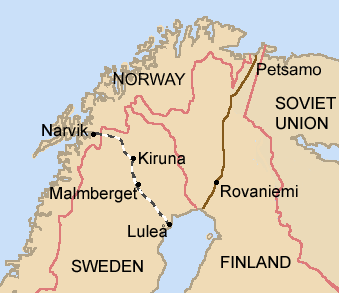 |
Above: Swedish iron ore was extracted in Kiruna and Malmberget and brought by rail to ice-free Narvik harbor in neutral Norway and Sweden’s Luleå harbor. Luleå harbor and surrounding sea were blocked by ice in the winter. The May–June 1940 German conquest of France, with that country’s iron ore fields in Lorraine, minimized the importance of Scandinavian exports to Germany.
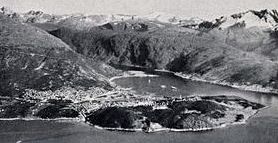 | 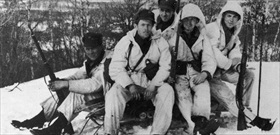 |
Left: Narvik provided an ice-free harbor in the North Atlantic for iron ore transported by rail from Sweden’s Kiruna ore mine. Both sides in the war had an interest in denying this iron supply to the other, setting the stage for a resumption of large-scale land battles in April 1940 following the German and Soviet invasions and annexations of Poland eight months earlier.
![]()
Right: The total number of Norwegian defenders during the Battle of Narvik (April 9 to June 8, 1940) was 8,000–10,000. French, British, and Polish forces in and around Narvik brought the total Allied force to 24,500 men. Facing them were 5,600 German soldiers, paratroopers, and shipwrecked sailors.
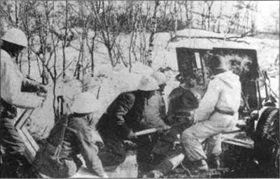 | 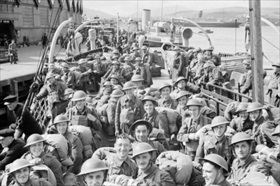 |
Left: The Battle of Narvik, which started with the German capture of the vital rail terminus and harbor in Norway’s north at the start of Operation Weseruebung, provided the Allies with their first major land victory in World War II on May 29, 1940.
![]()
Right: However, the successful German attack on France in May and June 1940 forced the Allied expeditionary force to evacuate Norway, which these British soldiers did in June. Without Allied air and naval support, Norwegians at Narvik were forced to lay down their arms, doing so on June 10, 1940, the last Norwegian forces to surrender their country to the invaders.
Newsreel of German Invasion of Denmark, Norway, Belgium, and the Netherlands
![]()

 History buffs, there is good news! The Daily Chronicles of World War II is now available as an ebook for $4.99 on Amazon.com. Containing a year’s worth of dated entries from this website, the ebook brings the story of this tumultuous era to life in a compelling, authoritative, and succinct manner. Featuring inventive navigation aids, the ebook enables readers to instantly move forward or backward by month and date to different dated entries. Simple and elegant! Click
History buffs, there is good news! The Daily Chronicles of World War II is now available as an ebook for $4.99 on Amazon.com. Containing a year’s worth of dated entries from this website, the ebook brings the story of this tumultuous era to life in a compelling, authoritative, and succinct manner. Featuring inventive navigation aids, the ebook enables readers to instantly move forward or backward by month and date to different dated entries. Simple and elegant! Click 











